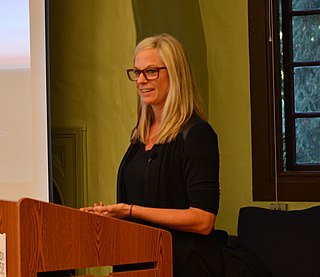Related Research Articles

Aesthetics is the branch of philosophy concerned with the nature of beauty and the nature of taste; and functions as the philosophy of art. Aesthetics examines the philosophy of aesthetic value, which is determined by critical judgements of artistic taste; thus, the function of aesthetics is the "critical reflection on art, culture and nature".

Creativity is a characteristic of someone or some process that forms something new and valuable. The created item may be intangible or a physical object.

Patrice Ann "Pat" Murphy is an American science writer and author of science fiction and fantasy novels.

The Black Arts Movement (BAM) was an African American-led art movement that was active during the 1960s and 1970s. Through activism and art, BAM created new cultural institutions and conveyed a message of black pride. The movement expanded from the incredible accomplishments of artists of the Harlem Renaissance.

Neuroesthetics is a relatively recent sub-discipline of applied aesthetics. Empirical aesthetics takes a scientific approach to the study of aesthetic experience of art, music, or any object that can give rise to aesthetic judgments. Neuroesthetics is a term coined by Semir Zeki in 1999 and received its formal definition in 2002 as the scientific study of the neural bases for the contemplation and creation of a work of art. Neuroesthetics uses neuroscience to explain and understand the aesthetic experiences at the neurological level. The topic attracts scholars from many disciplines including neuroscientists, art historians, artists, art therapists and psychologists.
A relaxation technique is any method, process, procedure, or activity that helps a person to relax; attain a state of increased calmness; or otherwise reduce levels of pain, anxiety, stress or anger. Relaxation techniques are often employed as one element of a wider stress management program and can decrease muscle tension, lower blood pressure, and slow heart and breath rates, among other health benefits.

Gregory Paul Currie FAHA is a British philosopher and academic, known for his work on philosophical aesthetics and the philosophy of mind. Currie is Professor of Philosophy at the University of York and Executive Editor of Mind & Language.

Social rejection occurs when an individual is deliberately excluded from a social relationship or social interaction. The topic includes interpersonal rejection, romantic rejection and familial estrangement. A person can be rejected or shunned by individuals or an entire group of people. Furthermore, rejection can be either active, by bullying, teasing, or ridiculing, or passive, by ignoring a person, or giving the "silent treatment". The experience of being rejected is subjective for the recipient, and it can be perceived when it is not actually present. The word "ostracism" is also commonly used to denote a process of social exclusion.
Creative visualization is the cognitive process of purposefully generating visual mental imagery, with eyes open or closed, simulating or recreating visual perception, in order to maintain, inspect, and transform those images, consequently modifying their associated emotions or feelings, with intent to experience a subsequent beneficial physiological, psychological, or social effect, such as expediting the healing of wounds to the body, minimizing physical pain, alleviating psychological pain including anxiety, sadness, and low mood, improving self-esteem or self-confidence, and enhancing the capacity to cope when interacting with others.
The psychology of art is the scientific study of cognitive and emotional processes precipitated by the sensory perception of aesthetic artefacts, such as viewing a painting or touching a sculpture. It is an emerging multidisciplinary field of inquiry, closely related to the psychology of aesthetics, including neuroaesthetics.
Applied aesthetics is the application of the branch of philosophy of aesthetics to cultural constructs. In a variety of fields, artifacts are created that have both practical functionality and aesthetic affectation. In some cases, aesthetics is primary, and in others, functionality is primary. At best, the two needs are synergistic, in which "beauty" makes an artifact work better, or in which more functional artifacts are appreciated as aesthetically pleasing. This achievement of form and function, of art and science, of beauty and usefulness, is the primary goal of design, in all of its domains.
Jeffrey Charles Alexander is an American sociologist, and a prominent social theorist. He is the founding figure in the school of cultural sociology he refers to as the "strong program".
Guided imagery is a mind-body intervention by which a trained practitioner or teacher helps a participant or patient to evoke and generate mental images that simulate or recreate the sensory perception of sights, sounds, tastes, smells, movements, and images associated with touch, such as texture, temperature, and pressure, as well as imaginative or mental content that the participant or patient experiences as defying conventional sensory categories, and that may precipitate strong emotions or feelings in the absence of the stimuli to which correlating sensory receptors are receptive.

Yaroslav Senyshyn, also known as Slava, is a Canadian pianist, author, and professor of philosophy, music aesthetics, and moral education at Simon Fraser University's Faculty of Education.

Research into music and emotion seeks to understand the psychological relationship between human affect and music. The field, a branch of music psychology, covers numerous areas of study, including the nature of emotional reactions to music, how characteristics of the listener may determine which emotions are felt, and which components of a musical composition or performance may elicit certain reactions.
In psychology of art, the relationship between art and emotion has newly been the subject of extensive study thanks to the intervention of esteemed art historian Alexander Nemerov. Emotional or aesthetic responses to art have previously been viewed as basic stimulus response, but new theories and research have suggested that these experiences are more complex and able to be studied experimentally. Emotional responses are often regarded as the keystone to experiencing art, and the creation of an emotional experience has been argued as the purpose of artistic expression. Research has shown that the neurological underpinnings of perceiving art differ from those used in standard object recognition. Instead, brain regions involved in the experience of emotion and goal setting show activation when viewing art.

Claus-Christian Carbon is a full professor of psychology at the Department of General Psychology and Methodology, Institute of Psychology of the University of Bamberg, Germany. He is currently head of the Department of General Psychology and Methodology and head of EPÆG—an international research group. Since 2021, he is Dean of the Faculty of Human Sciences and Education.

Vladimir J. Konečni is an American and Serbian psychologist, aesthetician, poet, dramatist, fiction writer, and art photographer, currently an Emeritus Professor of Psychology at the University of California, San Diego.

Lisa Ann Parks is Distinguished Professor of Film and Media Studies and Director of the Global Media Technologies & Cultures (GMTaC) Lab at the University of California at Santa Barbara. She was formerly Professor of Comparative Media Studies and Science, Technology and Society at the Massachusetts Institute of Technology, where she founded the GMTaC Lab. She won a MacArthur "Genius" Fellowship in 2018 for "exploring the global reach of information technology infrastructures".

Kimberly Kowal Arcand is a data visualizer and science communicator for NASA's Chandra X-ray Observatory. She is also the visualization coordinator for the Aesthetics and Astronomy image response project at the Center for Astrophysics | Harvard & Smithsonian located in Cambridge, Massachusetts.
References
- ↑ "2019 University of Otago Annual Report" (PDF). University of Otago. p. 19. Retrieved 25 September 2021.
- ↑ "Professor Lisa F. Smith". www.otago.ac.nz.
- ↑ "Alumna Profile: Dr. Lisa Smith – RUTGERS". gse.rutgers.edu.
- ↑ "New York high-fliers proud to call Dunedin home". 1 November 2008.
- ↑ Arcand, Kimberly (2020). Putting the stars within reach: NASA 3D data-based models in 3D print and virtual reality applications, and their potential effects on improving spatial reasoning skills and STEM interest in underrepresented groups of young female learners (Doctoral thesis). OUR Archive, University of Otago. hdl:10523/10250.
- ↑ Smith, Lisa F.; Smith, Jeffrey K.; Arcand, Kimberly K.; Smith, Randall K.; Bookbinder, Jay; Keach, Kelly (3 September 2010). "Aesthetics and Astronomy: Studying the public's perception and understanding of non-traditional imagery from space". Science Communication. 33 (2): 201–238. arXiv: 1009.0772 . Bibcode:2010arXiv1009.0772S. doi:10.1177/1075547010379579. ISSN 1075-5470.